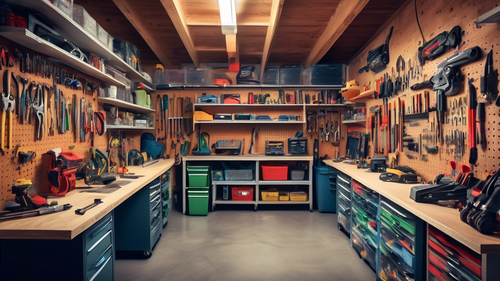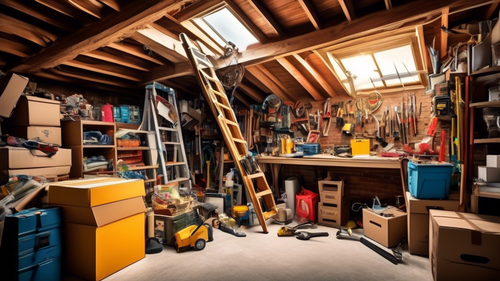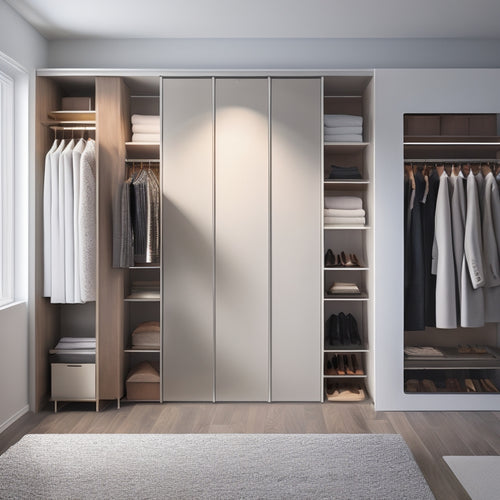
What's the Best Way to Organize a Growing Closet?
Share
You're ready to tame your growing closet! Start by scrutinizing every nook and cranny to identify areas for optimization. Purge your wardrobe ruthlessly, creating a donation pile for unused items. Categorize and group similar items, organizing by color for visual appeal. Assign zones for clothing storage and create stations for accessories. Maximize vertical storage with shelves, hooks, and storage units reaching the ceiling. By following these steps, you'll be well on your way to a clutter-free closet that sparks joy. Now, take the next step to creating a customized system that works for you.
Key Takeaways
• Assess the closet's shape, size, and layout to identify areas for space optimization and potential for repurposing space.
• Purge unwanted items ruthlessly, considering a capsule approach and seasonal rotations to streamline the wardrobe.
• Categorize and group similar items, organizing by color for visual appeal and navigation, and implementing style coordination for outfit pairing.
• Assign zones and stations for clothing storage, accessories, and shelving solutions, utilizing storage bins for out-of-season items.
• Maximize vertical storage by utilizing shelves, hooks, and storage units reaching the ceiling, and customizing adjustable shelves for changing needs.
Assessing Your Closet Space
Take stock of your closet space by standing in the middle of the room and scrutinizing every nook and cranny, letting your gaze linger on cluttered shelves, cramped corners, and overflowing storage bins. You're not just looking for dust bunnies; you're on a mission to assess your closet's layout and identify areas ripe for space optimization.
Notice how your closet's shape and size dictate the flow of traffic. Are there any awkward corners or dead zones? Where do you naturally gravitate when you enter the space? Take note of the placement of your closet's doors, windows, and any built-in shelving or storage units. Are there any areas that feel cramped or claustrophobic?
As you take inventory, ask yourself some pivotal questions. Can you easily access the items you need? Are there any areas that are underutilized or wasted? Are there any opportunities to repurpose or reimagine the space?
Purging and Editing Content
Now that you've assessed your closet space, it's time to tackle the contents.
You'll need to be ruthless and get rid of items that no longer fit, are worn out, or simply don't make you feel good.
Weed Out the Unwanted
You're staring at a closet bursting with clothes, shoes, and accessories, but before you can organize what's left, you need to purge the items that no longer serve a purpose.
It's time to get real – those skinny jeans from high school aren't coming back, and that faded t-shirt from your favorite band's concert is better suited for a rag.
Start by pulling out items you haven't worn in the past year (be honest, you won't miss them). Create a donation pile for gently used items and consider resale options for higher-end or trendy pieces.
As you sort, be prepared to confront your emotional attachment to certain items. Remember, the decluttering process is about freeing yourself from the guilt of keeping something 'just in case.'
Ask yourself, 'Would I buy this again if I saw it in a store today?' If the answer is no, it's time to let it go.
Streamline Your Wardrobe
How do you envision your ideal wardrobe, and what essentials will you need to create a cohesive, stylish look that makes you feel confident and prepared for any occasion?
Now that you've purged your closet of unwanted items, it's time to streamline your wardrobe. Consider adopting a capsule wardrobe approach, where you focus on a limited number of high-quality, versatile pieces that can be mixed and matched to create multiple outfits. This will help you make the most of your clothes and reduce decision fatigue.
To take it to the next level, implement seasonal rotations to guarantee your wardrobe stays fresh and relevant. This means storing out-of-season clothes and swapping them out with new pieces that fit the current climate.
Color coordination is also key – stick to a palette that works for you and experiment with outfit pairings to create a cohesive look. Remember, the goal is to create a wardrobe that makes you feel like a rockstar, not one that overwhelms you.
Categorizing and Grouping Items
By categorizing and grouping similar items together, such as tops, bottoms, and dresses, you'll create a sense of order and make it easier to locate specific pieces in your closet. Think of it like a party – you wouldn't invite all your friends and expect them to mingle without introducing them, right? Same with your clothes! Grouping similar items helps you see what you have and what you can create with them.
Next, take it to the next level with color coordination. Organize items by hue, from light to dark, to create a visually pleasing and easy-to-navigate space. You can also implement seasonal rotation, storing out-of-season clothes to free up space and reduce clutter.
For a more advanced approach, try style coordination – grouping items by style, like workwear or casual wear. This helps you see what pieces can be paired together to create new outfits. Finally, experiment with item pairing, where you match pieces that complement each other, like a statement top with a pair of high-waisted jeans.
Assigning Zones and Stations
Now that you've categorized and grouped your items, it's time to think about how you'll use your closet's space.
You'll want to assign zones for clothing storage, like areas for tops, bottoms, and dresses, to keep similar items together.
You'll also create stations for accessories, like a spot for jewelry, hats, or scarves, to keep them organized and easy to find.
Clothing Storage Areas
Your closet's real estate is valuable, so dividing it into zones and stations for specific clothing items will help you make the most of the space. Think of it like a mini department store - you've got different sections for different types of items. Start by designating areas for tops, bottoms, dresses, and outerwear.
Within each zone, use shelving solutions and drawer dividers to separate items further. For example, you might've a shelf dedicated to folded sweaters and another for jeans.
When it comes to hanging options, consider categorizing items by type, like dresses, tops, and pants. You can also use storage bins to store out-of-season clothing or items that you don't need frequent access to. Label each bin so you can easily find what you're looking for.
Accessory Organization Stations
You can further optimize your closet's functionality by dedicating specific stations to accessories, like jewelry, hats, scarves, and belts, which will keep them organized and easily accessible. This way, you'll avoid the frustration of digging through a messy pile of accessories just to find that one perfect piece.
| Accessory | Organization Solution | Benefits |
|---|---|---|
| Jewelry | Jewelry organization station with separate compartments | Easy to find the perfect piece, prevents tangling and scratching |
| Belts | Belt hooks on a wall-mounted rack | Saves space, keeps belts organized and untangled |
| Scarves | Scarf hangers on a clothing rod | Maximizes vertical space, keeps scarves wrinkle-free and organized |
Maximizing Vertical Storage
By installing shelves, hooks, and storage units that reach up to the ceiling, every available inch of vertical space is utilized, effectively doubling or even tripling your closet's storage capacity. You'll be amazed at how much more you can fit in your closet without feeling cramped.
When utilizing shelving, consider adjustable shelves that can be customized to fit your changing needs. This way, you can easily switch from storing bulky winter sweaters to summer dresses. Hanging solutions are also a game-changer. Install double rods to maximize your hanging space, and use stackable hanging organizers to store items like purses, scarves, or belts.
Don't forget about the often-wasted space above your closet rod – install a shelf or hooks to hang items like hats, bags, or even a few favorite outfits. With a little creativity, you can turn your closet into a storage powerhouse.
Maintaining the Organized Space
How will you guarantee that your newly organized closet doesn't revert to its former cluttered state? The answer lies in regular closet maintenance. Set aside some time each week to tidy up and put back items that are out of place. This will prevent clutter from building up again and keep your space optimized.
To make maintenance easier, implement a 'one in, one out' policy. For every new item you bring into your closet, get rid of an old one to maintain a balanced amount of possessions. This will prevent your closet from expanding unnecessarily and keep your space organized.
Additionally, schedule a deeper clean every season to tackle any areas that need extra attention. Go through your clothes, shoes, and accessories, and donate or discard items that no longer fit or make you happy.
Frequently Asked Questions
Can I Use a Closet Organizer System on a Slanted Ceiling?
"You're not stuck with a sloping ceiling nightmare! You can totally rock a closet organizer system, even with a slanted ceiling. Consider custom shelves and adjustable hanging rods to create a functional, fabulous space that's tailor-made for your unique ceiling situation."
How Do I Handle Items That Don't Fit Into Categories?
You'll inevitably encounter miscellaneous items that defy categorization, so develop an organization strategy that accommodates unusual shapes - think creative storage solutions, like baskets or shelves, to corral those oddball items that don't fit neatly into categories.
Are Over-The-Door Storage Solutions Worth the Investment?
You're wondering if over-the-door storage solutions are worth the investment? They're great for maximizing vertical space, but consider alternative storage options. Weigh the benefits (extra storage, easy access) against drawbacks (cluttered look, potential damage) before deciding.
What's the Best Way to Store Out-Of-Season Clothing?
You're wondering what to do with those out-of-season clothes, right? Store them in vacuum sealed bags and stow them under your bed using under bed storage - it's like a secret hideaway for your winter sweaters!
Can I DIY a Custom Closet Organization System on a Budget?
You can totally DIY a custom closet organization system on a budget! Get creative with budget-friendly solutions, custom designs, and space-saving hacks to maximize your closet's potential without breaking the bank.
Related Posts
-

Garage Hardware Organization Made Easy
Ah, the garage – that sanctuary for all things DIY and everything else that doesn't fit in the house. But let's b...
-

Garage Attic Storage: What You Need to Know
Garage Attic Storage: Everything You Need to Know As a home improvement enthusiast with a passion for decluttering...
-

Declutter Your Closet With Digital Essentials
You're about to transform your closet from a cluttered chaos to a curated sanctuary with the power of digital essenti...


